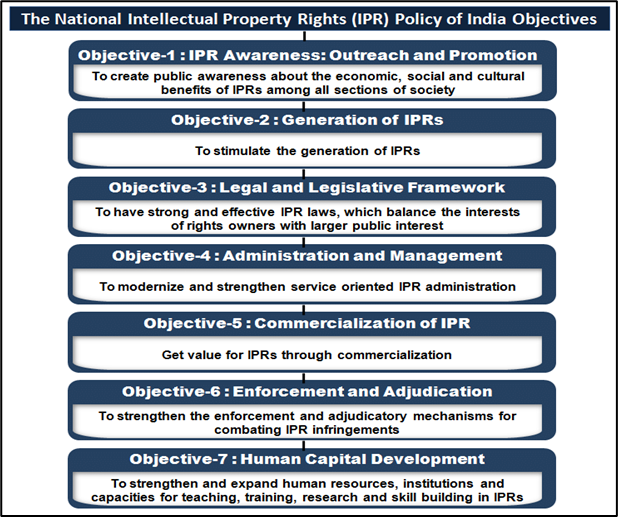Context:
- In 2016, the then Department of Industrial Policy and Promotion (now known as the Department for Promotion of Industry and Internal Trade) under the Ministry of Commerce released the National IPR Policy.
- The overall purpose of this policy was to spell out the government’s comprehensive vision for the IPR ecosystem in the country towards shaping a more innovative and creative Bharat.
- The article emphasizes how excessive IPR sensitivity might harm the public interest.

Broad Objectives of the National IPR Policy:
- Legal and Legislative Framework: The goal was to have strong and effective IPR laws, which balance the interests of right owners with larger public interest.
- Administration and Management: The objective was to modernise and strengthen service-oriented IPR administration.
- Enforcement and Adjudication: The focus was to strengthen the enforcement and adjudicatory mechanisms for combating IPR infringements.
How the Policy Aided in Making Legislative and Structural Changes?
- For instance, the Intellectual Property Appellate Board (IPAB) was dissolved in (April) 2021 as part of tribunal reforms, and its jurisdiction was re-transferred to High Courts.
- This was followed by the establishment of dedicated IP benches (“the IP Division”) by the Delhi HC, arguably the country’s leading court on the IPR front, for speedier disposal of IPR disputes.
- These steps have gone hand in hand with a conscious effort to improve the infrastructure and strength of the Indian Patent Office.
- Such measures are intended to convey to investors and innovators that Bharat is an IP-savvy and even IP-friendly jurisdiction without compromising on national interest and public health commitments.
- This is evident from the contribution of the Indian pharmaceutical sector in enabling access to affordable medicines globally and its transformation to being the pharmacy of the world.
Issue of Evergreening of Patents:
- What is the evergreening of patents?
- Provisions such as Sections 3(d), 53(4) and 107A of the Patents Act 1970 were introduced between 2002 and 2005 to prevent the mischievous practice of “evergreening” of patents.
- The evergreening of patents is a practice of tweaking drugs in order to extend their patent term and thus their profitability.
- India's prohibition on evergreening aids millions of people who can't afford the expensive modified drugs, as well as the development of domestic generic drug makers.
- However, evergreening patents on drugs which relate to treatment of diabetes, cancers, cardiovascular diseases, etc., continue to be granted to pharmaceutical innovator companies by the Indian Patent Office and enforced through courts.
- Why is patent monopoly/evergreening of patents granted?
- The economic assumption behind the Patent Bargain (private risk is rewarded and incentivised in return for a limited private monopoly right) is to have a trickle-down impact that benefits the general population.
- Therefore, patent monopolies are granted to innovators in the hope that they disclose something new, inventive and of industrial value to the public.
- How is this misused by the patent owners?
- The Patent Bargain becomes a Faustian bargain (in which a person abandons his or her moral principles in order to obtain benefits) since it results in the illegal extension of the 20-year term of the monopoly.
- This, in turn, undermines competition in the market and enables patentees to extract more from the society than permitted.
- What is the Supreme Court’s verdict in this regard?
- In Novartis AG v. Union of India & Others (2013), the apex court held that the legislative intent behind the insertion of Section 3(d) in the Act is to prevent the evergreening of a patent monopoly that in no way enhances the drug’s therapeutic efficacy.
- However, the SC’s verdict has not yielded any positive outcomes both from the Patent Office and subordinate courts, rather it delayed entry of generic versions.
- This, in turn, adversely affects the availability of affordable medicines to patients in countries such as Bharat where most middle-class or below families are on the verge of spending their hard-earned funds after a hospital visit.
Conclusion:
- There are four stakeholders under the Patents Act - the society, government, patentees and their competitors. Each of these stakeholders has rights under the statute which makes all of them right owners.
- The legal rights of other stakeholders are curtailed when the Act is interpreted, applied, and enforced exclusively in the patentees' favour, especially when those patentees are evergreening.
- Thus, the IPR ecosystem must strike a fine balance to attract investment on one hand and promote public health obligations, long-term national interest on the other.









